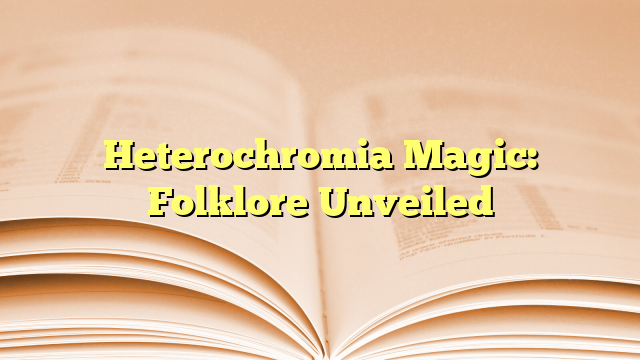Central heterochromia refers to an eye condition where the inner ring of the iris is a different color from the outer ring. While not as common as complete heterochromia (where each eye is a different color), central heterochromia has inspired various myths, folklore, and cultural beliefs. This phenomenon has caught the attention of societies around the world, leading to diverse interpretations and tales.
Influence on Modern Perceptions: Throughout history, traits that deviate from the norm often sparked myths and superstitions. Central heterochromia, though primarily an aesthetic variation, has occasionally been interpreted as an indicator of supernatural abilities or divine origins. However, modern perceptions of central heterochromia have evolved, often being seen as unique and beautiful rather than inherently mystical.
Myths and Influences:
- Mystical Abilities: In some cultures, central heterochromia was associated with individuals possessing special powers or insight. These beliefs may have arisen from a fascination with those who appeared different from the majority.
- Divine Significance: In ancient times, unique physical traits were sometimes attributed to divine origins. Individuals with central heterochromia might have been thought to be touched by the gods or having a unique connection to the spiritual realm.
- Influence on Art and Literature: Central heterochromia, being visually striking, often found its way into art, literature, and storytelling. Characters with distinctive eyes have appeared in myths, folktales, and literature, reflecting the human tendency to link physical traits with personality traits.
Medical and Historical Context: While central heterochromia itself does not typically coincide with serious medical conditions, it can be seen in conjunction with genetic factors, such as the presence of multiple eye colors within a family. Notable historical figures like Alexander the Great are believed to have had central heterochromia, which sometimes fueled myths and legends surrounding their unique traits.
Insights into Human Perception: The prevalence of myths and folklore around central heterochromia provides a fascinating insight into human psychology and societal perceptions. Our tendency to weave stories around physical differences reveals our complex relationship with individuality and the human desire to attribute meaning to what sets us apart.
Common Themes and Motifs: The folklore around central heterochromia often touches on themes that resonate deeply within the human psyche:
- Otherworldly Origins: Beliefs that individuals with unique traits like central heterochromia had otherworldly or divine origins highlight our curiosity about the unknown and our longing for connection with the mystical.
- Special Destinies: Many myths suggest that those with central heterochromia possess special destinies or abilities. This reflects the human fascination with the extraordinary and the potential for individuals to transcend the ordinary.
- Beauty in Uniqueness: Modern perceptions have shifted toward celebrating uniqueness and diversity. The shift from mystical interpretations to appreciating central heterochromia’s aesthetic appeal reflects changing societal attitudes.
Conclusion: The folklore and myths surrounding central heterochromia offer a glimpse into the intricate interplay between physical traits, cultural beliefs, and human psychology. While interpretations have shifted over time, the enduring fascination with unique features speaks to our innate need to understand ourselves and the world around us through stories and symbols.
